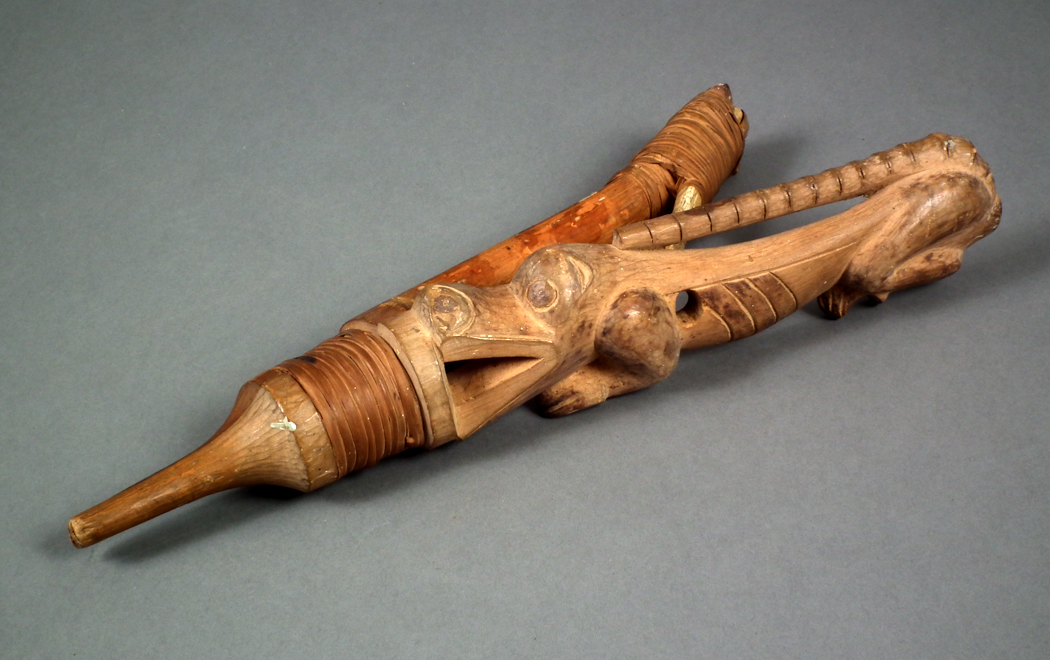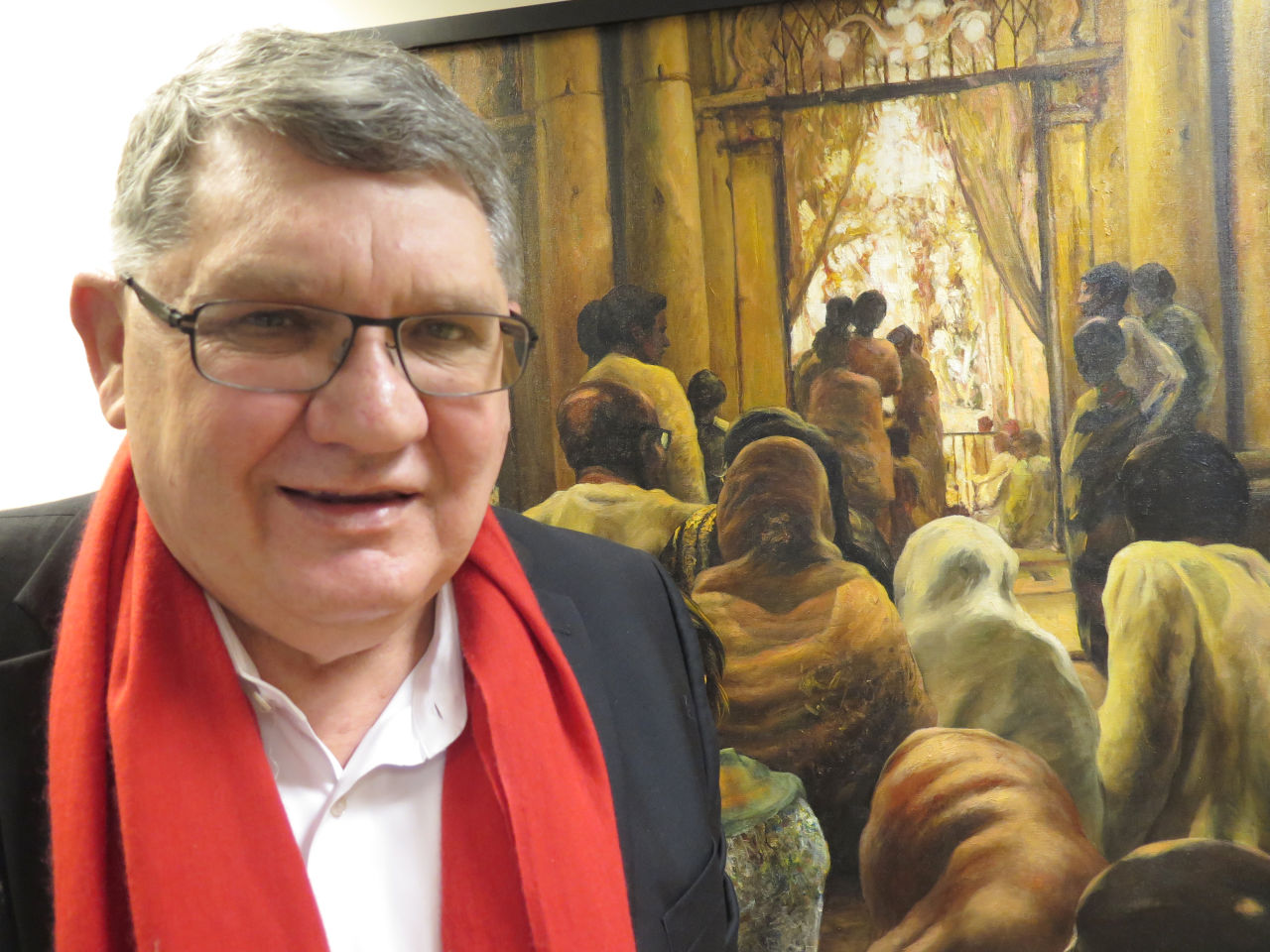Advertisement
What A Native American Fish Hook's Journey Says About A Little-Known Repatriation Law
Throughout history Native Americans have had their land, possessions and culture taken away. But in recent decades the U.S. government has worked to right some wrongs through repatriation. Museums and federally funded institutions are required to go through their collections and report artifacts that might belong to tribes.
Now a small theological school in Newton is navigating this complex legal process for the first time.
Its collection of about 125 Native American artifacts includes one known as the Halibut Hook, and a lot of people are interested in its fate.

David Katzeek is one of them. He sang for me over the phone, like tribal fishermen have for centuries as they lower a V-shaped, ornately carved, wood-and-bone hook into the water
“We would stomp our feet,” Katzeek recalled, and continued to chant in his ancestral language. The ceremonial hook is part of a ritual that helps fishermen honor the fish’s sacrifice. Halibut, like all living things, have a spirit, he believes, and his tribesmen would talk and sing to the fish below.
“They would be warning and letting the halibut know that it was coming to do battle with them,” Katzeek said, then explained the meaning behind the fishermen’s words: "'You’re going to fight with this, it’s going to fight with you.' "
Katzeek leads the Thunderbird Clan in Southeast Alaska. He says the Halibut Hook (known to him as the G̱ooch Ḵuyéik Náxw, translation: "Halibut Hook with Wolf Spirit") is a treasured spiritual object.
Now Katzeek and the Central Council of the Tlingit and Haida Indian Tribes are fighting to reclaim the Halibut Hook they believe is theirs.
But the hook is not in Alaska — it’s in Massachusetts, in the collection of the Andover Newton Theological School (ANTS), the oldest graduate seminary in the United States.
Advertisement
The tribes didn’t know where this Halibut Hook was until last summer. That's when they learned the financially struggling school was thinking of selling or transferring dozens of Native American artifacts as it weighed the future of its campus. (In November ANTS announced it was putting the campus on the market, citing decline in enrollment, and would either relocate or merge with another school.)
The school’s trove — along with the Halibut Hook — has been stored at the Peabody Essex Museum (PEM) in Salem for decades.
“This Halibut Hook — which has carved clan figures on it — is quite distinctive,” the museum’s director, Dan Monroe, told me. “A just straight-forward, functional Halibut Hook has quite a different form.”

Monroe looked at a photo of the Halibut Hook while in his office. He explained that the story of how an object like this hook might go back to Alaska, after decades in Massachusetts, reveals the complexities of a legal process that repatriates potentially sacred artifacts.
“The level of pain surrounding these issues is hard for many people to understand,” Monroe said, “but it’s very real.”
He knows the dark history behind that pain well. The PEM holds the largest collection of Native American artifacts in the Northern Hemisphere. And Monroe lived and worked in Alaska for years, where he developed relationships with the tribes there.
He talked to me about missionaries who fanned out across the U.S. in the late 1800s and 1900s to convert Native Americans. With westward expansion, he said people feared Indian culture would be eradicated.
“There had already been tremendous displacement of native people through disease, warfare and forced removal from their tribal lands, so there was there was this ‘fear of the vanishing red man,' ” Monroe described, “which was the way that this was characterized. Consequently not only missionaries but natural history museums began an intensive period of collecting Native American material.”
That’s where a law known as NAGPRA comes in. The acronym stands for the Native American Graves Protection and Repatriation Act. Monroe had a hand in designing it in 1990.
“The whole history of Indian policy in this country is painful,” said Melanie O’Brien, the NAGPRA program manager at the U.S. Department of the Interior. “NAGPRA was enacted to try to help fix some of those painful pasts.”
Since 1990 the act has required museums and federally funded institutions to submit lists of human remains and sacred or cultural objects. Hundreds of tribes can review the inventories and make claims to their cultural heritage.
Staff at the Andover Newton school say they didn’t fully understand its responsibility to NAGPRA that came to light when it briefly explored the sale or transfer of its Native American collection. The Interior Department alerted the school that it needed to comply with the law and is helping the school navigate the repatriation process.
“It’s a daunting responsibility,” admitted Nancy Nienhuis, a dean at the school, “and I’m not an expert — I’m a theologian by training, so this is new territory for me.”
Now it’s also become her job to document dozens of artifacts, consult with experts, and ultimately contact dozens of tribes. It’s like sleuthing, Nienhuis said, because the histories behind many of the objects — including the Halibut Hook — are elusive and challenging to trace.
It is believed that in the 1830s a Presbyterian missionary is responsible for five of the objects. Others were gifts from alumni. But Nienhuis said most of the paperwork and information about the artifacts’ pasts has been lost overtime.
“It’s not like a movie where you get to see that story unfold. We don’t know who the original donor was. We don’t know if they’re the ones who received the objects originally,” she said. “Did someone give it to them? Are they the daughter or son of someone? Without knowing exactly how things came to us, it’s very difficult to be able to tell the story of any particular object.”
Piecing those stories together takes a long time, Nienhuis said, because it's crucial for the school to get it right. O’Brien explained that while the repatriation process is rigorous and intentionally deliberate, careful and slow, “I don’t think that Congress envisioned it would take quite so long to resolve the rights to all of these cultural items,” she said. “I’m not sure that Congress realized how many were in the possession or control of museums and federal agencies.”
But according to O’Brien, ownership rights to more than 1.6 million Native American cultural items, human remains and funerary objects have been resolved since 1990.
Even so, scores of others — like the Halibut Hook — are still undetermined.
That’s frustrating to tribe members and Rosita Worl, president of the nonprofit Sealaska Heritage Institute in Juneau.
“Some clans haven’t had what we call 'at.óow' -- they’re clan ceremonial objects, and they haven’t been able to participate in our ceremonies,” Worl explained.
Worl has been working with clan leaders, including Katzeek from the Thunderbird Clan, on their claim to the ceremonial Halibut Hook. She’s of the Tlingit tribe and told me that when sacred objects are repatriated, the healing effects reach beyond a single tribe.
“It’s brought museums and tribes together. We have better working relationships,” she said. “I also think it’s contributed to the knowledge about the belief systems and spirituality around the objects.”
Worl is a former NAGPRA Review Committee member and acknowledged the 25-year-old law isn’t perfect. Barriers include a lack of funding and the amount of time and money tribes, museums and institutions spend on the repatriation process. Next week the NAGPRA Review Committee will ask Congress for more support.
Meanwhile, Worl hopes the unfolding story of this Halibut Hook’s fate raises awareness for other institutions that might not know or understand what they might have in their collections.
Correction: An earlier version of this report misspelled Nancy Nienhuis' last name. We regret the error.
This article was originally published on March 04, 2016.
